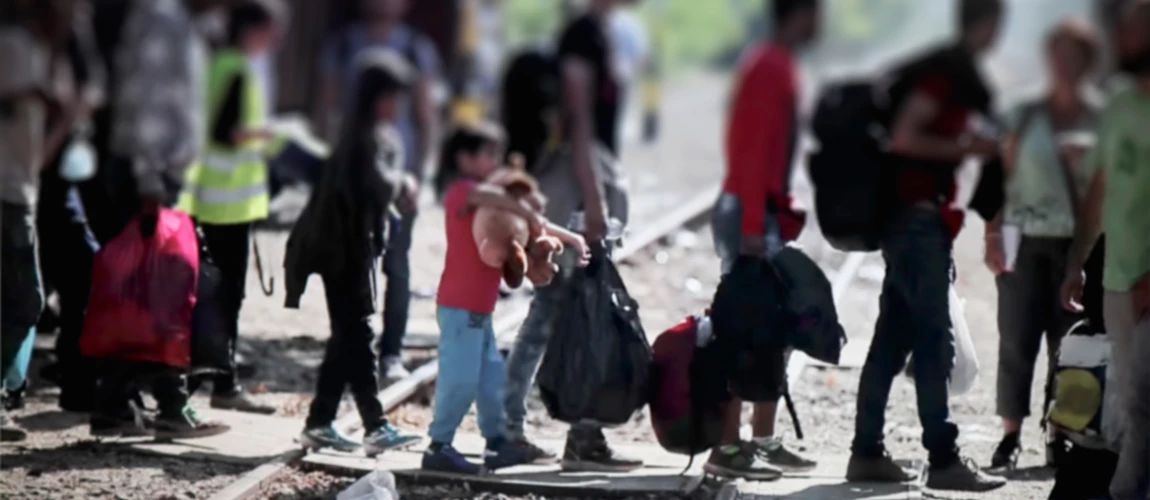 Migrant family at a checkpoint
Migrant family at a checkpoint
This blog entry is part of a series that highlights insights from research for development policies and practices, supported by the Knowledge for Change Program (KCP).
At the end of 2020, 82.4 million people were forcibly displaced worldwide, which accounts for more than 1 percent of the world’s total population. Most of them had no choice but to leave their homes to escape wars, violence, or sustained conflicts. By 2030, the World Bank estimates that up to two-thirds of the world’s extreme poor will live in fragile and conflict-affected (FCV) countries, and the already-dim global fragility landscape is currently being further exacerbated by the distressing situation in Afghanistan, Haiti, and many other parts of the world.
December 18 is the International Migrants Day, and we want to focus this blog on the migrants who were forcibly displaced – those who were involuntarily moved out of their homes due to violence and conflict. The first set of projects explored innovative ways to measure and track refugee conditions when field-based data collection was not feasible. The second one studied the economic consequences of the inflow of refugees on the labor market in host countries. And the third set of projects, which are still ongoing, put the spotlight on programs that go beyond basic economic services, and focus on the social and emotional well-being of refugees.
1. Measure it, count it, and manage it: leveraging nontraditional data and methods to measure poverty for refugees and people living in FCV.
Collecting household or individual level data for refugees or people living in FCV settings continues to be a challenge, and high-quality microdata on these populations are rare. In fact, the global count of the poor excludes the majority of displaced populations because these populations are not usually captured by censuses. Two KCP projects explored innovative methods to measure and track poverty in a data-scarce setting.
One recently completed KCP study in Afghanistan demonstrates that call detail records could be used in practice to target antipoverty programs. The project duration was from March 2019 to June 2021, and all analyses were done before August 15, 2021.The study combined rich survey data from a “big push” program for ultra-poor households in Afghanistan with detailed mobile phone logs from study participants. Researchers studied the extent to which machine learning methods can accurately differentiate ultra-poor households eligible for a program’s benefits from other households deemed ineligible. The findings show that supervised machine learning methods that leverage mobile phone data can identify ultra-poor households as accurately as standard survey-based measures of poverty, including consumption and wealth. Moreover, combining survey-based measures with mobile phone data produces more accurate classification than those based on a single data source.
These results extend past work on wealth estimation from mobile phone data to suggest that call detail records and other “digital trace” data—behavioral indicators recorded in everyday interactions with technology—could be used in practice to target anti-poverty programs or other development interventions. Call detail records–based methods could serve as a lower-cost complement to standard targeting methods without sacrificing accuracy, and they could be particularly useful in times of conflict or humanitarian crisis when field-based targeting is not feasible. Despite some limitations, including phone coverage, privacy, and strategic gaming, these results show how innovative methods can be deployed in conjunction with standard targeting methods to improve measuring and help fill gaps when field-based data collection is infeasible.
Another KCP project completed in 2019 presented an alternative approach to estimate poverty for refugees using data from Jordan and Chad. UNHCR global registration data (ProGres) is one of the most comprehensive databases on refugees. Currently, the dataset has information on socioeconomic characteristics of all registered individuals and households, but it doesn’t contain data on consumption. In order to identify ways to better understand poverty among refugees, a team of researchers employed a cross-survey imputation method to estimate poverty for refugees using only a few proxies of poverty available in ProGres data and validated the method in the context of Jordan and Chad. The Jordan study showed that the imputation-based poverty estimates based on ProGres data were not statistically different from the consumption-based poverty rates, and the result was robust to various validation tests. The results from Chad also demonstrated that poverty estimation using ProGres data can predict household consumption reasonably well. While these findings concur with those from existing imputation studies for the general population, implementing a similar imputation exercise across countries using different data sets and welfare aggregates would provide more evidence for scaling up the model for refugees. But the findings are especially promising because ProGres data are available in most refugee locations, and thus these estimation methods could potentially be replicated in many settings of forcibly displaced persons.
2. Economic integration: the effects of the inflow of refugees on the labor market in host countries
A body of research is looking into the effects of Syrian refugees in the labor market and their economic and social integration into the host countries. A KCP-financed project examined the effects of Syrian refugees in the Turkish labor market. It was discovered that primarily because Syrian refugees were not able to obtain work permits, they were overwhelmingly employed in the informal sector. This corresponds to the observation that the flow of refugees were a well-defined supply shock to the informal sector. But the impact on formal employment was more mixed. Consistent with theories in occupational upgrading, there was evident growth in formal employment for Turks, but the increase only occurred among men without completed high school education. These findings represented the short-term impact of refugees in Turkey, but questions remain on the ways to integrate refugees economically and socially into the hosting society.
Another ongoing KCP project explores the effective social and economic integration of Syrian refugees in Jordan. The project evaluates the impacts of the labor-intensive public work program for Syrian refugees in Jordan on labor market outcomes, productivity, stereotyping beliefs on other groups, and social cohesion. The public work program, which is implemented under the World Bank–assisted Municipal Services and Social Resilience Projects, offers temporary jobs in the construction of basic infrastructure (e.g., roads, sidewalks, public leisure spaces) for both Syrian refugees and Jordanian residents. The findings will be very much of relevance to foster development in Jordan and other hosts of refugees in the world.
3. Going beyond basic support: what about mental and emotional well-being of refugees?
Being displaced from home can have lasting mental health and other effects on refugees. Understandably, the majority of refugee support programs focus on the provision of basic services and economic interventions. But in the long term, refugees may suffer from mental, emotional, and psychosocial losses, especially for children and adolescents, who may be more harshly affected by forced displacement. Do refugees with better mental health better integrate? A KCP-supported project on refugees in Australia reveals that worse mental health reduces the probability of employment by almost 15% and labor income of almost 27%. There was also some evidence that indicates detrimental impacts of refugees mental illness on their children’s mental health and educational achievements. Furthermore, is it possible to cultivate a sense of “home” in refugee camps? An ongoing KCP project on Rohingya refugees in Bangladesh is designed to understand and potentially address the psychological loss incurred by displaced persons. In 2021, nearly 900,000 Rohingya refugees are being sheltered in refugee camps in neighboring Bangladesh. The project partners with Terre des Hommes (TDH) to evaluate one of the programs that encourage Rohingya children to engage in various activities in mobile, child-friendly spaces in a camp.
In KCP’s new phase, we will continue to support the research agenda on fragility, conflict, and violence. More innovative research and novel data on rising global refugees will be produced to help inform policies for receiving governments and international communities.
The authors would like to acknowledge contributions from the following projects under the guidance of task team leads (TTLs) and researchers: Migration and Labor Market Implications in the South (TTL: Caglar Ozden); A home away from home: improving the lives of adolescent refugees (TTLs: Erin Kelley and Eric Mvukiyehe); Social and economic integration of Syrian refugees in host communities in Jordan (TTL: Marcus Holmlund); Cellphone records to estimate poverty impacts (TTLs: Aidan Coville and Guadalupe Bedoya); and Poverty imputation handbook and research (TTL: Hai-Anh Dang) .
About the blog series: The Knowledge for Change Program (KCP) has launched a blog series to retrospectively highlight a selection of research projects conducted over the past 20 years, many of which still remain highly relevant and offer great lessons for development policies and practices today. Managed by the Development Economics Vice Presidency of the World Bank (DEC), the KCP promotes evidence-based policy making through research, data and analytics. To celebrate the KCP’s fourth phase launched in November 2020, this blog series will look into the wealth of knowledge researchers have generated in KCP’s previous phases, distill lessons learned, and inspire discussions on future research directions.




Join the Conversation